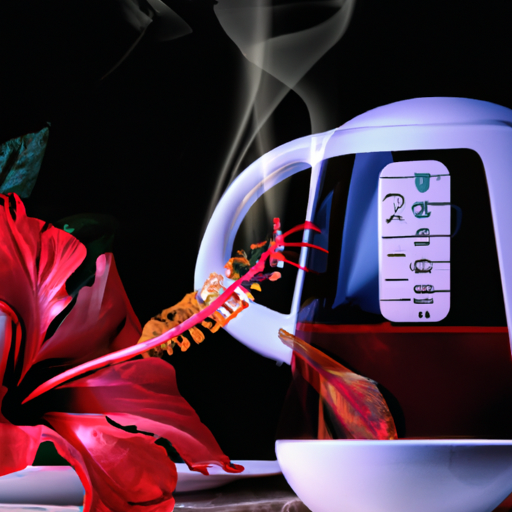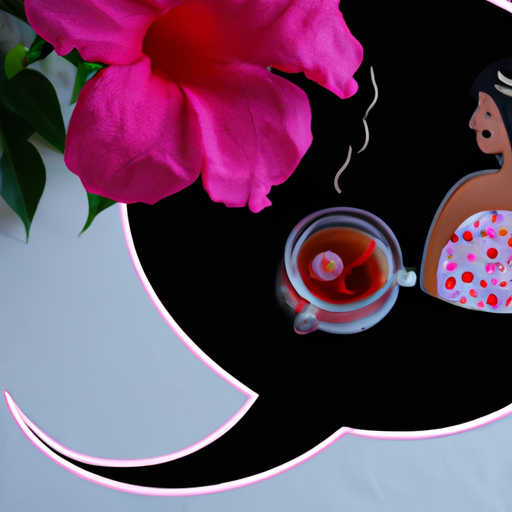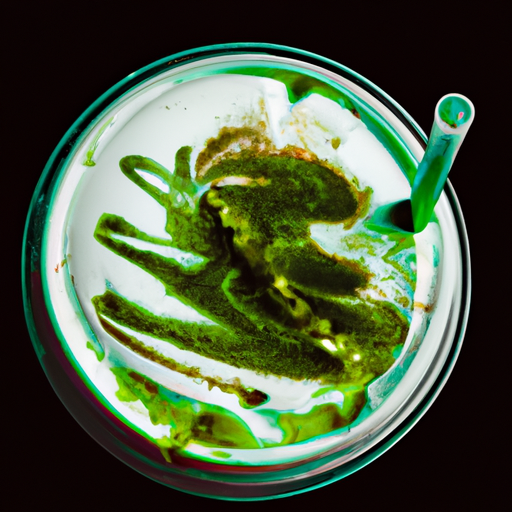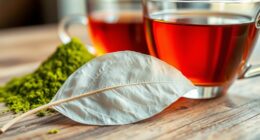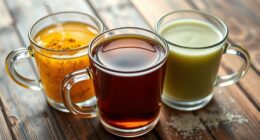As a person battling hypertension, I’m always on the lookout for natural treatments to keep my high blood pressure in check. Hibiscus tea has gained a lot of attention lately as a remedy. It’s not just appealing for its taste, which is both delightful and invigorating, but research indicates it can reduce blood pressure as well.
In this article, I will walk you through the steps of preparing hibiscus tea for maximum blood pressure-lowering effects, as well as discuss potential side effects and additional health benefits of incorporating it into your diet.
Hibiscus tea is made from the dried calyces of the hibiscus flower and has been used for centuries in traditional medicine practices around the world. While there are many varieties of hibiscus tea available on the market, not all are created equal when it comes to reducing blood pressure. It’s important to choose a high-quality organic brand that contains at least 1.25 grams of dried hibiscus per serving in order to reap its full benefits.
Once you have found a suitable brand, it’s time to start brewing!
Key Takeaways
- Hibiscus tea is made from dried calyces of the hibiscus flower and can lower blood pressure levels due to its anthocyanins content.
- To prepare hibiscus tea, use fresh or dried whole flowers and steep 2-3 teaspoons per cup in boiling water for 5-10 minutes. Adding lemon juice or honey can enhance the flavor and health benefits.
- Drinking a cup before breakfast and another before dinner can significantly reduce blood pressure in hypertensive individuals. Pairing hibiscus tea with exercise can further enhance its benefits on cardiovascular health.
- Consult with a healthcare professional before incorporating hibiscus tea into your diet if you’re taking any medications or have a history of allergies. Oversteeping hibiscus tea can make it too bitter.
Overview of Hibiscus Tea
You’re probably wondering what hibiscus tea is and why it’s important for lowering your blood pressure. Hibiscus tea is a herbal infusion made from the dried calyces of the hibiscus flower. It has been used for centuries in traditional medicine to treat various ailments such as high blood pressure, liver diseases, and fever. Recent studies have shown that drinking hibiscus tea can help lower blood pressure levels.
One of the main benefits of hibiscus tea is its ability to lower blood pressure. This effect is thought to be due to the presence of compounds called anthocyanins, which are potent antioxidants that help protect against oxidative stress and inflammation in the body.
In addition to lowering blood pressure, hibiscus tea may also improve cholesterol levels, reduce insulin resistance, and promote weight loss.
When brewing hibiscus tea for its therapeutic benefits, it’s important to follow a few tips to ensure maximum potency. Use fresh or dried whole flowers rather than pre-packaged teabags, as they may contain lower-quality parts of the plant or additives. Steep 2-3 teaspoons of dried flowers per cup in boiling water for 5-10 minutes before straining and serving. Adding lemon juice or honey can enhance both the flavor and health benefits of this refreshing drink.
Now that you know about some of the benefits and brewing tips for hibiscus tea, let’s move on to choosing the right type of tea for your needs.
Choosing the Right Hibiscus Tea
When looking for the perfect hibiscus brew, it’s important to keep in mind that not all teas are created equal – some may have stronger flavors than others, while some may be more potent in their health benefits.
Here are a few things to consider when choosing the right hibiscus tea:
-
Types: Hibiscus tea comes in various types such as loose-leaf, tea bags, or powders. Loose-leaf is generally considered the best option as it offers better flavor and quality compared to other types. Tea bags are convenient, but they often contain lower grade ingredients and lack potency.
-
Benefits: Hibiscus tea has numerous health benefits, including reducing blood pressure levels, cholesterol levels, and improving heart health. It also contains antioxidants which help protect against cell damage caused by free radicals.
-
Organic vs Non-Organic: When choosing hibiscus tea, it’s essential to check whether it’s organic or non-organic. Organic hibiscus tea is grown without synthetic pesticides or fertilizers and has no harmful chemicals that can be detrimental to our bodies.
-
Brand Reputation: When buying hibiscus tea, always opt for reputable brands with positive customer reviews. This ensures that you’re getting a high-quality product that delivers on its promises.
Choosing the right type of hibiscus tea is crucial in preparing a perfect cup of this delicious beverage with significant health benefits. Now let’s move on to the next section where I’ll show you how easy it is to prepare your own cup of freshly brewed hibiscus tea at home!
Preparing Hibiscus Tea
Get ready to enjoy a delicious and healthy cup of hibiscus tea with this simple recipe! Preparing hibiscus tea is easy, but it requires some care and attention.
The first step is to choose high-quality hibiscus flowers and the right tea accessories.
To prepare hibiscus tea, you’ll need a teapot or a mug with an infuser. Start by boiling water and letting it cool for a few minutes (optimal temperature is around 200°F). Add 1-2 tablespoons of dried or fresh hibiscus flowers per cup of water to the infuser or directly into your pot/mug.
Pour hot water over the flowers and let them steep for 5-10 minutes, depending on how strong you like your tea. Then remove the infuser (if using one) or strain the mixture through a cheesecloth or sieve.
The steeping time for hibiscus tea plays an important role in obtaining its health benefits. Hibiscus flowers contain anthocyanins, flavonoids, and other compounds that have been shown to help lower blood pressure, reduce inflammation, and improve cholesterol levels.
Oversteeping can make the tea too bitter, so stick to 5-10 minutes as recommended above.
Once you have prepared your base hibiscus tea, you can experiment with different flavors by adding herbs, spices, fruits, or sweeteners – see next section for inspiration!
Ready to add some flavor to your homemade hibiscus tea? There are many ways to customize your brew according to your taste preferences: try adding mint leaves for freshness; ginger root for warmth; cinnamon sticks for sweetness; honey or agave nectar instead of sugar; lemon juice or slices for tanginess; pomegranate seeds or raspberries for extra antioxidants…
The possibilities are endless! Just remember that even though these ingredients can enhance the flavor profile of your hibiscus tea, they may also add calories or sugar, so use them in moderation.
Adding Flavor to Hibiscus Tea
To enhance the taste of your homemade hibiscus tea, try experimenting with various flavor combinations. Adding refreshing mint leaves or warming ginger root can give it a little kick. These ingredients also have health benefits that complement the blood pressure-lowering effects of hibiscus tea.
Here are some sweetener options to consider when adding flavor to your hibiscus tea:
- Honey: A natural sweetener that’s less refined than sugar and has antioxidant properties.
- Stevia: A calorie-free sweetener derived from the stevia plant.
- Agave nectar: A low-glycemic index sweetener made from the agave plant.
When preparing your hibiscus tea, be sure to add these ingredients in moderation as they can increase the calorie count and affect the overall blood pressure-lowering benefits.
By adding different flavors and natural sweeteners, you can make your hibiscus tea more enjoyable while still benefiting from its medicinal properties. Now let’s move on to maximizing the blood pressure-lowering effects of this powerful herbal infusion.
Maximizing Blood Pressure-Lowering Effects
You can amplify the potency of this herbal infusion by implementing some simple tweaks to your daily routine. Timing consumption is one of the most important factors when it comes to maximizing the blood pressure-lowering effects of hibiscus tea. Drinking a cup before breakfast and another before dinner has been shown to significantly reduce systolic and diastolic blood pressure in hypertensive individuals.
Additionally, pairing hibiscus tea with exercise can further enhance its benefits on cardiovascular health. A study published in the Journal of Nutrition found that combining moderate-intensity exercise with hibiscus tea consumption resulted in greater reductions in both systolic and diastolic blood pressure compared to just drinking the tea alone.
It’s important to note that while hibiscus tea is generally safe for most people, it may interact with certain medications and cause unwanted side effects.
In the next section, we’ll discuss potential side effects and precautions you should take when consuming this herbal infusion.
Potential Side Effects
As I continue to explore the potential benefits of hibiscus tea in lowering blood pressure, it’s important to consider its potential side effects.
Two key points that come to mind are interactions with medications and allergic reactions. It’s important to be aware of these potential risks and consult with a healthcare professional before incorporating hibiscus tea into your diet, especially if you’re taking any medications or have a history of allergies.
Interactions with Medications
Be cautious if you’re taking medication for blood pressure, warns the pharmacist, because hibiscus tea can enhance their effects and cause your blood pressure to drop too low, just like how adding too much salt to a recipe can ruin the dish. It is important to consult with your healthcare provider before incorporating hibiscus tea into your routine if you are currently taking medications for blood pressure.
Table: Interactions between Hibiscus Tea and Medications
| Medication | Potential Interaction | Precautions |
|---|---|---|
| ACE inhibitors (e.g. lisinopril) | Hibiscus tea may enhance their effects and cause blood pressure to drop too low. | Consult with a healthcare provider before incorporating hibiscus tea into routine. |
| Diuretics (e.g. furosemide) | Hibiscus tea may increase potassium levels in the body when taken with certain diuretics. | Monitor potassium levels regularly when consuming hibiscus tea alongside diuretics. |
| Antihypertensive drugs (e.g. atenolol) | Hibiscus tea may enhance their effects and cause blood pressure to drop too low. | Consult with a healthcare provider before incorporating hibiscus tea into routine if currently taking antihypertensive drugs. |
It is important to note that interactions between herbs or supplements and medications can be unpredictable and vary among individuals, so seeking guidance from a healthcare professional is always recommended.
Moving on to potential allergic reactions…
Allergic Reactions
If you experience symptoms such as itching, hives, or difficulty breathing after consuming hibiscus tea, it may be a sign of an allergic reaction. Although rare, allergic reactions to hibiscus tea can occur in some individuals.
If you suspect that you’re having an allergic reaction after drinking hibiscus tea, seek medical attention immediately. Treatment options for allergic reactions to hibiscus tea include antihistamines and epinephrine injections.
Antihistamines can help relieve mild symptoms such as itching and swelling whereas epinephrine injections are used to treat severe symptoms such as difficulty breathing and anaphylaxis.
It’s important to note that if you have a known allergy to plants in the Malvaceae family (including cotton, cocoa, and okra) or have experienced previous allergic reactions to hibiscus tea, it’s recommended to avoid consuming it altogether.
Now let’s move on to the next section about monitoring blood pressure.
Monitoring Blood Pressure
To keep track of your blood pressure, you should monitor it regularly and record the readings in a journal. This can help you identify any patterns or changes in your blood pressure over time. You can check your blood pressure at home using a portable monitoring device or by visiting your doctor’s office.
Here are some tips to help you monitor your blood pressure effectively:
- Take readings at the same time each day
- Sit with your feet flat on the floor and back supported
- Avoid caffeine, alcohol, and exercise for at least 30 minutes before taking a reading
- Record both systolic (top number) and diastolic (bottom number) readings
By tracking your blood pressure regularly, you can make informed decisions about lifestyle changes that may help lower it. These lifestyle changes could include reducing sodium intake, increasing physical activity, maintaining a healthy weight, and managing stress.
Incorporating hibiscus tea into your diet is one potential way to lower blood pressure naturally. By consuming this tea regularly as part of a balanced diet and healthy lifestyle, you may be able to achieve better control over your blood pressure levels.
Incorporating Hibiscus Tea into Your Diet
Incorporating hibiscus tea into your daily routine is a simple and delicious way for you to take control of your health and make positive changes in your diet. Hibiscus tea has many health benefits, including lowering blood pressure, reducing inflammation, and improving digestion. It’s also rich in antioxidants, which can help protect against cancer and other chronic diseases.
To prepare hibiscus tea, simply steep dried hibiscus flowers in hot water for several minutes until the water turns a deep red color. You can add honey or lemon juice to taste if desired. Hibiscus tea can be enjoyed both hot or cold, making it a versatile drink that can be incorporated into any diet.
There are many recipe ideas for incorporating hibiscus tea into your diet beyond just drinking it as a beverage. You can use it as an ingredient in smoothies or cocktails, mix it with sparkling water for a refreshing spritzer, or even use it as a marinade for meats or vegetables.
With its delicious tart flavor and numerous health benefits, there’s no reason not to start incorporating hibiscus tea into your daily routine today.
In addition to its blood pressure-lowering properties, hibiscus tea has many additional health benefits such as reducing cholesterol levels and improving liver function. These added benefits make it an even more valuable addition to any healthy diet.
Additional Health Benefits
You’ll be happy to know that hibiscus tea has been shown to reduce LDL cholesterol levels by up to 22%, which can greatly improve your heart health. But that’s not all – this tea also boasts a variety of other health benefits due to its unique nutritional content and brewing techniques.
Here are just a few additional health benefits of hibiscus tea:
- It’s rich in antioxidants, which can help protect cells from damage caused by free radicals.
- It may help lower blood sugar levels and improve insulin sensitivity, making it a potential aid in managing diabetes.
- Its anti-inflammatory properties may benefit those with conditions such as arthritis or inflammatory bowel disease.
- It has diuretic properties, meaning it may help flush excess fluids out of the body and alleviate bloating or water retention.
- Some studies suggest that hibiscus tea may even have anti-cancer effects.
To reap these benefits, make sure you prepare your hibiscus tea using proper brewing techniques. This typically involves steeping dried or fresh flowers in boiling water for several minutes before straining and enjoying. And don’t forget – while hibiscus tea can be enjoyed on its own, it also pairs well with other flavors such as lemon or ginger for an added boost of taste and nutrition.
Frequently Asked Questions
Can hibiscus tea be consumed if you are taking medication for high blood pressure?
As someone who takes medication for high blood pressure, I understand the importance of being cautious when it comes to consuming certain foods and drinks.
When it comes to hibiscus tea, there are some interactions and precautions to be aware of. Hibiscus tea has been shown to lower blood pressure in some people, which can be beneficial for those with hypertension.
However, if you are already taking medication to lower your blood pressure, consuming large amounts of hibiscus tea may cause your blood pressure to drop too low. It’s important to speak with your healthcare provider before incorporating hibiscus tea into your diet as they can advise on safe amounts and potential interactions with any medications you’re currently taking.
Is hibiscus tea safe for pregnant women to drink?
Pregnancy concerns are important when it comes to consuming any kind of herbal tea, including hibiscus tea. While hibiscus tea is generally considered safe for consumption during pregnancy, it’s recommended that pregnant women limit their intake to no more than one or two cups per day.
Additionally, it’s important to consult with a healthcare provider before adding any new food or beverage to your diet while pregnant. Dosage recommendations may vary depending on individual circumstances and health conditions, so it’s always best to err on the side of caution and seek professional advice.
Overall, while hibiscus tea can be a healthy addition to your diet, especially for its potential blood pressure-lowering benefits, it’s important to prioritize the safety of both you and your unborn child.
How long does it take for hibiscus tea to start lowering blood pressure?
I remember the time when I first started drinking hibiscus tea to manage my blood pressure. It was a hot summer day, and I had just finished my morning workout routine. As I sat down to enjoy a cup of iced hibiscus tea, I felt an immediate sense of calm wash over me. It was like my body was thanking me for nourishing it with this refreshing drink.
To answer the question at hand, research suggests that it takes about two to six weeks of consistent consumption of hibiscus tea to see significant reductions in blood pressure levels. However, it’s important to note that the duration of its effects may vary from person to person depending on factors such as age, gender, and overall health status.
The best time to consume hibiscus tea for blood pressure improvement is before meals or throughout the day as a replacement for sugary or caffeinated beverages. This allows your body to absorb its nutrients more efficiently and promote better circulation.
In conclusion, incorporating hibiscus tea into your diet can have numerous health benefits, including lowering blood pressure levels over time. Remember that consistency is key when it comes to reaping its full potential benefits!
Can hibiscus tea interact with other medications or supplements?
As someone who’s researched the effects of hibiscus tea on blood pressure, I can say there are potential safety concerns and drug interactions to consider when consuming this beverage alongside other medications or supplements.
While hibiscus tea is generally safe for most people, it may interact with certain drugs such as diuretics, antihypertensives, and aspirin.
Additionally, those taking medication for liver disease or kidney problems should avoid drinking hibiscus tea in large amounts.
It’s always best to consult with a healthcare provider before adding any new supplement or beverage to your routine to ensure it’s safe and won’t interfere with other medications you may be taking.
What is the recommended daily intake of hibiscus tea for lowering blood pressure?
For those looking to lower their blood pressure, hibiscus tea can be a helpful addition to their daily routine. Studies have shown that consuming 2-3 cups of hibiscus tea per day can provide significant health benefits. These benefits include reducing blood pressure levels, improving cholesterol levels, and promoting overall heart health.
Incorporating hibiscus tea into one’s daily routine is a simple yet effective way to support cardiovascular health and promote overall well-being. The recommended daily intake amount varies depending on the individual and their specific health needs. So, it is important to consult with a healthcare professional before making any significant dietary changes.
Conclusion
As I sip on my freshly brewed hibiscus tea, I can’t help but think of the beautiful flower that it came from.
Just like how the hibiscus blooms in vibrant colors and brings joy to those who see it, this tea has the potential to bring health benefits and lower blood pressure for those who drink it.
It’s important to choose the right type of hibiscus tea and prepare it properly in order to maximize its effects. And just like how we need to take care of our bodies with healthy habits, we must monitor our blood pressure and be aware of any potential side effects.
By incorporating hibiscus tea into our diets, we can add a delicious beverage that not only quenches thirst but also promotes better health.
So let us raise a cup of hibiscus tea in celebration of both beauty and wellness.

